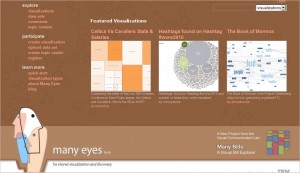Well, probably not the next really big thing. But data sharing has certainly begun to establish a perch in the social media world. And companies that make use of other social networking opportunities should keep an eye on the developing social data space.
What is the social data space? A broad definition would include one of the most-visited websites in the world: Wikipedia. Wikipedia provides a location in which people can work together to amass and improve information on almost any topic imaginable. Insofar as data and information are the same thing, Wikipedia is the ultimate in social data publishing.
A more strict definition would focus on data that fits in spreadsheets–and visualization sites like Many Eyes, Tableau Public, and Swivel that allow users to format and share spreadsheet data online. Users can bring their own info (for example, non-sensitive business data) or grab some from an open source (typically a government agency or non-profit organization) and create an information graphic that is publicly visible. Others can add to the product, link to it, or comment on it.
Essentially, the social data space is like YouTube for facts and numbers. In addition to the data viz sites already mentioned, there are also sites that make it easy to get/create/share just the data itself. Socrata, for example, offers an easy-to-use interface for accessing government info like White House visitor records, and also hosts user-created datasets that range from Le Sarkometre (the 113 promises made by candidate Sarkozy) to World’s Largest Cathedrals (embellished with photos, Wikipedia links, and factoids like approximate volume). There are even specialty sites like StatPlot, where sports fans have communal fun with figures.
The introductory video on Tableau Public’s home page offers a nice look at the possibilities of data visualization, and the blog Information Aesthetics has in-depth reviews of Many Eyes and Swivel that will help orient newcomers to the data viz space. IA also offers an overview of Google’s data apps.
Relevance for corporate recruiting? It’s common practice now for companies to have an established social media presence that includes (at least) YouTube, Facebook, and Twitter. They may also use other social media channels targeted to particular user groups. So for companies that do a lot of recruiting in the areas of technology, science, IT, analytics, and so on—it seems like the social data space would be a natural next step. Businesses could post interesting visualizations based on their own data, look for passive candidates in the online communities, and embed interesting/relevant visualizations in company weblogs, just like YouTube videos.
I don’t know of any companies or recruiters actively utilizing the social data space, but it’s bound to happen. Worth considering, anyway!
Cynthia Giles has followed a serpentine career path from academia to publishing to marketing and design to information technology and corporate communications. There’s plenty of detail about this journey at www.cynthiagiles.com, but briefly--the common theme has been ideas, and how to present them effectively. Along the way, she became an accidental expert on data warehousing and business intelligence, and for the past ten years she has combined corporate contracting with an independent consulting practice that focuses on marketing strategy for smaller businesses and non-profits.
Having spent quite a bit of time looking for work, and anywhere from two weeks to two years inside a wide variety of American companies—she has given much thought to what works (and what doesn’t) when it comes to creating a great employment fit.



